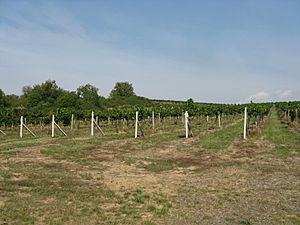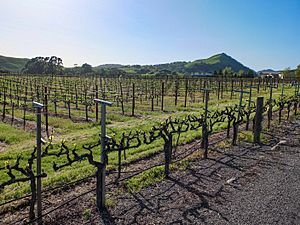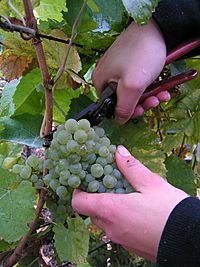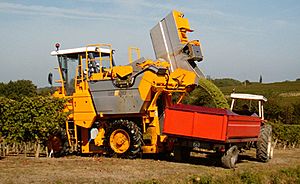Viticulture facts for kids

Viticulture is all about growing and harvesting grapes. It's a special part of horticulture, which is the science of growing plants. The common grape vine, Vitis vinifera, first grew in places from Western Europe to the Persian shores of the Caspian Sea. But grapes are super adaptable! You can find viticulture on every continent except Antarctica.
People who work in viticulture are called viticulturists. Their jobs include checking for and stopping pests and diseases. They also add fertilizer, manage irrigation, and trim the grape leaves. Viticulturists watch the fruit grow and decide the best time to pick the grapes. They also prune the vines in winter. Viticulturists often work closely with winemakers. This is because how the grapes are grown greatly affects the winemaking process. Many types of grapes are now approved in the European Union for growing and making wine.
Contents
History of Grape Growing
People started growing grape vines and making wine about 8,000 years ago. The story of viticulture is closely linked to the history of wine. Humans were growing wild grapes to make wine as far back as the Neolithic period. Some of the first grape vines were grown in what are now Georgia and Armenia.
The oldest known winery was found in the "Areni-1" cave in Vayots Dzor, Armenia. It's about 6,100 years old (from 4100 BC). This site had a wine press, special pots for fermenting, jars, and cups. Archaeologists also found grape seeds and vines there. Experts believe that winemaking was already very advanced back then. This means the technology probably started much earlier. There is also proof of grape growing in the Near East around 3200 BC.
We know about ancient viticulture from old writings on clay tablets, plant remains, and archaeological digs. Old wine jars help us learn about how people drank wine and what grapes they grew. Besides making wine, grapes were also grown to make raisins.
Early grape growers learned to prefer vines that could pollinate themselves. These vines were called hermaphroditic. Over time, these self-pollinating vines produced more of their own kind.
Around 400 BC, the Greek historian Thucydides wrote:
The people of the Mediterranean began to emerge from barbarism when they learnt to cultivate the olive and the vine.
He was likely talking about the time between 3000 BC and 2000 BC. This is when grape growing became very important in Asia Minor, Greece, and the Cyclades Islands. During this time, growing grapes changed from just feeding local people to being a big part of international trade.
Roman Grape Growing
From 1200 BC to 900 BC, the Phoenicians developed ways to grow grapes. These methods were later used in Carthage. Around 500 BC, a Carthaginian writer named Mago wrote about these practices. The Roman statesman Cato the Elder learned from these texts. Around 160 BC, he wrote De Agricultura, which talked about Roman grape growing.
Later, around 65 AD, the Roman writer Columella wrote a very detailed book called De Re Rustica. This book was one of the first to describe using trellis systems. These systems raise vines off the ground. Columella suggested using stakes instead of letting vines grow up tree trunks. Stakes made it safer to prune the leaves and harvest the grapes.
As the Roman Empire grew across Western Europe, they brought their grape-growing methods with them. This led to some of the world's most famous winegrowing regions. These include Rioja in Spain, Mosel in Germany, and Bordeaux, Burgundy, and Rhône in France. Roman viticulturists were among the first to realize that steep hillsides were great places to plant vines. This is because cool air flows downhill, so the vines on slopes get more warmth.
Medieval Grape Growing
Catholic monks, especially the Cistercians, were very important grape growers during the Middle Ages. During this time, a system called Metayage started in France. Laborers worked the vineyards under agreements with landowners. The workers often had freedom to choose their crops and how they grew them.
In northern Europe, the cold and damp weather made grape growing hard. So, certain grape types were chosen that did better in these conditions. Most vineyards grew white grapes, which are tougher in cold, wet climates. Some red grapes, like Pinot Noir, were also introduced.

The book Les Très Riches Heures du duc de Berry from 1416 shows farming and grape growing in France. It shows peasants pruning grapes and harvesting them.
Many grape-growing methods from this time became common in Europe until the 1700s. People studied different grape types to see which ones grew best in certain areas. An early idea of terroir began to form. This means that wines from specific places started to be known for their unique qualities. The idea of pruning for better quality, not just more grapes, also started. This often caused arguments between rich landowners who wanted high-quality wines and peasant workers who needed to sell a lot of wine to live. The Riesling wine is a famous example of this focus on higher quality. In 1435, Count John IV of Katzenelnbogen started this successful tradition.
In Burgundy, the Cistercian monks developed the idea of cru vineyards. These were specific areas of land that consistently produced similar wines every year. In places like the Côte-d'Or, the monks divided the land into separate vineyards. Many of these, like Montrachet and La Romanée, still exist today.
Grapes in Mythology
In Greek mythology, the demigod Dionysus (Bacchus in Roman mythology) was the son of Zeus. He is said to have invented the grapevine and the winepress. When his close friend, a satyr, died trying to bring him an important vine, Dionysus made the vine grow fruit. His fame spread, and he eventually became a god.
The Bible talks about wine and grapevines many times, both as symbols and literally. Grapes are first mentioned when Noah grows them on his farm (Genesis 9:20–21). The book of Proverbs (20:1) and Isaiah (5:1–25) also mention wine. Deuteronomy (18:3–5, 14:22–27, 16:13–15) describes wine being used during Jewish festivals. In Christianity, wine is a symbol of the Last Supper, representing the blood of Christ. It is mentioned several times in the New Testament. For example, Jesus uses the vine as a symbol for himself, saying, “I am the true vine (John 15:1).” Because of this, a vine is the only symbol on the tomb of Constantine the Great.
The Grape Vine
Most of the world's wine-producing regions are found in the temperate areas. These are between 30° and 50° latitude in both the northern and southern hemispheres. In these areas, the average yearly temperatures are between 10°C and 20°C (50°F and 68°F).
Large bodies of water like lakes and rivers, and mountain ranges, can help the climate and the vines. Nearby water can protect vines from big temperature drops at night. The water releases heat it stored during the day, warming the vines.
The Grape
A grape is a type of berry. On the vine, grapes grow in groups called clusters. Grape clusters can be loose or tightly packed. In some grape types, all the grapes in a cluster ripen at the same time, so they can be picked together. In others, grapes ripen individually within a cluster.
Each grape berry has a small stem called a pedicel that connects it to the main stem, called the rachis. The rachis helps the grapes get water and nutrients. After pollination and fertilization, each grape berry usually has one to four seeds. If fertilization doesn't happen, seedless grapes form. These are often used to make raisins. Most grape plants produce about 100 to 200 grapes.
The skin of the grape makes up 5% to 20% of its total weight, depending on the grape type. When grape skin ripens, it holds most of the grape's smells and tannins. These are important for winemaking, affecting things like color and flavor. Tannins are found throughout the grape, but they are most important during ripening. They help create the grape's color and body shape.
Growing Vines
Many things can affect how good a grape vine is. But the three most important are climate, slope, and soil. These are often called the terroir.
Climate
Climate is the biggest outside factor for a grape's quality. Each grape type prefers a specific environment to grow best. Since climates are different everywhere, choosing the right grape type is very important. Also, things like temperature and rain can be unpredictable. So, each year will produce grapes with unique qualities and amounts. Wine grapes are also very sensitive to climate change and temperature changes.
Grape vines need about 1300–1500 hours of sunshine during the growing season. They also need about 690 mm (27 inches) of rainfall throughout the year to make good grapes for wine. Ideally, most rain should fall in winter and spring. Rain during harvest time can cause problems like fungal diseases and grapes splitting. The best weather during the growing season is a long, warm summer. This allows grapes to ripen fully and balance their acids and sugars.
Hot and sunny climates have a growing season of 200 days or more without frost. In these climates, grapes ripen faster. They have higher sugar levels and lower acidity. Cooler climates have a frost-free growing season of about 150–160 days. Cooler seasons make grapes ripen earlier, leading to a fresher and more acidic harvest. Generally, the average yearly temperature for most grape crops should be around 15°C (59°F) for the best quality.
Summer: Ideal summer temperatures are around 22°C (72°F). This warmth helps fruits ripen. Temperature and sunshine are key for ripening.
Winter: Ideal winter temperatures are around 3°C (37°F). These temperatures are needed for grape vines to rest. If it gets too cold, the plants can be damaged.
Spring and Fall: Spring and fall are very important for grape growth. Plants can be hurt by frost, which damages the fruiting buds. Wet weather in spring can lead to mildew. To stop mildew, some farms use heaters or big fans, but these can be expensive.
Slope
Hillsides and slopes are better than flat ground for growing grapes. Vines on a slope get more direct sunlight. On flat ground, the sunlight spreads out more. Small slopes that are higher than the surrounding land are the best and safest places for crops. This is because these small hills are less likely to get frost. Also, a slope helps with drainage, so the vines don't sit in soil that's too wet. In cooler parts of the northern hemisphere, south-facing slopes get more sun and are preferred. In warmer areas, north-facing slopes are better. In the southern hemisphere, these directions are swapped.
Soil
Good soil is important for plants to have strong root systems. If the soil quality is poor, a vine's growth and health can suffer. Different grape types like different soil conditions, but there are some general good qualities. Good soil conditions include: aeration (air in the soil), loose texture, good drainage, and moderate nutrients. Drainage is considered the most important soil feature for grape vine growth. When roots can't grow well because of bad soil, the vine grows less, produces fewer grapes, and might only live for a few years.
Hazards for Grapes
Grape growers face many dangers that can harm the wine or even kill the vine.
- When the vine is flowering, it's very sensitive to strong winds and hail. Cold temperatures during this time can cause millerandage. This results in grape clusters with no seeds and grapes of different sizes. Hot conditions can cause coulure, where grape clusters either fall off or don't grow fully.
- Oidium is a powdery mildew that can attack all green parts of the vine. If not treated, it can kill the plant. It grows well in cooler temperatures and shade. Some North American vines have developed ways to resist this mildew.
- Downy mildew (Peronospora) grows well in high temperatures and humidity. It causes stains on leaves. It can be treated by spraying plants with copper sulphate. Most American vines are resistant, but Vitis vinifera is not.
- Fanleaf virus is spread by tiny worms called nematodes that live in the vine stem. It can make leaves look strange and yellow, and lead to smaller grape harvests. There is no cure for the plant. The best thing to do is remove infected plants and let their roots rot.
- Frost
- Phylloxera (a tiny insect that attacks roots)
- Plant viruses
- Pests (like insects or animals)
Green Harvest
A green harvest means removing grape bunches that are still green and not ripe. This is usually done to reduce the total number of grapes. When some bunches are removed, the vine puts all its energy into developing the remaining grapes. In theory, this helps the grapes ripen better and develop more flavors. If a healthy vine produces too many grapes, they might be watery and not fully ripe.
In Europe, many wine regions limit how many grapes can be grown in a certain area. So, green harvesting is often done if there are too many grapes. Often, the extra grapes have to be sold for very little money and used to make industrial alcohol instead of wine.
The idea of thinning grapes to improve quality has been around for a long time. But it has become more common recently in places like California, where grapes grow easily.
Field Blend
A field blend is a wine made from two or more different grape types planted in the same vineyard. In the past, before people could easily identify grape types, a vineyard might be planted by taking cuttings from another vineyard. This meant that one vine could be Zinfandel and the next Carignan. When making wine with simple equipment, field blends made it easy to mix grapes, even if it wasn't very flexible.
Today, fermentation tanks are affordable, so field blends are not as common. Almost all wines are made by blending different grape types that were fermented separately. However, in California, some of the oldest Zinfandel vineyards are field-blended. For example, Ridge Vineyards owns the Lytton Springs vineyards. These were planted from 1900 to 1905 with a mix of about 70% Zinfandel, 20% Petite Sirah, and 10% Grenache and Carignan.
Gemischter Satz is a German term for a field blend. It means that different grape types are planted, harvested, and fermented together. This used to be common but is now rare. However, it is a special tradition in Vienna.
See also
 In Spanish: Viticultura para niños
In Spanish: Viticultura para niños






